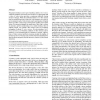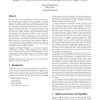118
click to vote
SIGGRAPH
2000
ACM
15 years 5 months ago
2000
ACM
This paper introduces a new type of medium, called a video texture, which has qualities somewhere between those of a photograph and a video. A video texture provides a continuous ...
108
Voted
SIGGRAPH
2000
ACM
15 years 5 months ago
2000
ACM
Visibility determination is a key requirement in a wide range of graphics algorithms. This paper introduces a new approach to the computation of volume visibility, the detection o...
99
Voted
SIGGRAPH
2000
ACM
15 years 5 months ago
2000
ACM
Approximating detailed models with coarse, texture-mapped meshes results in polygonal silhouettes. To eliminate this artifact, we introduce silhouette clipping, a framework for ef...
85
Voted
SIGGRAPH
2000
ACM
15 years 5 months ago
2000
ACM
We present a method for creating texture over an arbitrary surface mesh using an example 2D texture. The approach is to identify interesting regions (texture patches) in the 2D ex...
111
click to vote
SIGGRAPH
2000
ACM
15 years 5 months ago
2000
ACM
Advances in 3D scanning technologies have enabled the practical creation of meshes with hundreds of millions of polygons. Traditional algorithms for display, simplification, and ...
119
Voted
SIGGRAPH
2000
ACM
15 years 5 months ago
2000
ACM
Physical simulation of dynamic objects has become commonplace in computer graphics because it produces highly realistic animations. In this paradigm the animator provides few phys...
103
click to vote
SIGGRAPH
2000
ACM
15 years 5 months ago
2000
ACM
We present the WarpEngine, an architecture designed for realtime image-based rendering of natural scenes from arbitrary viewpoints. The modeling primitives are real-world images w...
106
Voted
SIGGRAPH
2000
ACM
15 years 5 months ago
2000
ACM
Subdivision surfaces solve numerous problems related to the geometry of character and animation models. However, unlike on parametrised surfaces there is no natural choice of text...
89
Voted
SIGGRAPH
2000
ACM
15 years 5 months ago
2000
ACM
SIGGRAPH
2000
ACM
15 years 5 months ago
2000
ACM
Surface elements (surfels) are a powerful paradigm to efficiently render complex geometric objects at interactive frame rates. Unlike classical surface discretizations, i.e., tri...


